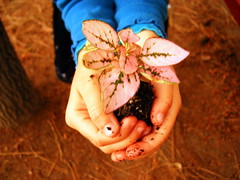 We have many experienced gardeners at SDCCS and some who have self-proclaimed "brown thumbs" but most of us live somewhere in- between...
We have many experienced gardeners at SDCCS and some who have self-proclaimed "brown thumbs" but most of us live somewhere in- between...Over the next couple of weeks and throughout the year, teachers, garden liasons and parent volunteers will be planting all sorts of veggies, herbs, trees, vines, seeds and flowers with our kids and maybe now is a good time for a refresher about the basics. First, a few definitions...
topsoil: the good dirt for our plants (not hardpan or clay or sand etc)
compost: decomposed plant matter that acts as food for the plants and earthworms
mulch: usually chipped bark used to hold in moisture...it covers the soil after planting, helps keep out weeds and keep in water... good for paths and walkways
6 pack (not the drinking kind or the muscle kind): 6 small plants sold together...the containers will be reused for seedlings
thinning: kind of obvious, but after you plant seeds... many of them so tiny its hard to sprinkle only a few... too many will sprout in one place and thinning is necessary for the plants to grow without overcrowding
pruning: cutting back a plant so it will grow bushier and healthier
dead-heading: snapping the dead flowers off a plant so all that growing energy can go into making more flowers/seed etc
companion planting: a method of planting that pairs kinds of veggies, herbs and flowers so their different properties can help eachohter thrive...for instance, some plants grow tall and shade seedlings that can't take full sun...or certain flowers keep snails away...or certain plants attract ladybugs that will eat aphids and white flies...and of course the reverse is true, and some plants do not do well next to others...onions can be tricky as can garlic and fennel.
OK, now a bit about planting...
When you are planting vegetables, herbs, and flowers it is best to squeeze and bend the plastic planter they are in to loosen them...if they are root-bound (in otherwords, the roots are a clumped together and often still in the shape of the planter...) it is necessary to rip off the bottom 1/4 of the root system. I know it sounds drastic but it will help the plant to drink right away and adapt to its new home.
It's also good to give your newly planted plants a gentle watering and be diligent about watering until they are established. And be prepared to weed a lot...make sure you have marked well the areas where you are expecting seedlings and try to differentiate between them and the weeds.
It is important to know enough about your plant to space them the proper distance...tomatos get huge, radishes not so much etc. Here's a good list for vegetable spacing but more research is necessary for many of the medicinal and culinary herbs that will be planted.
Veggie Spacing Guide
Asparagus 15-18 inches apart

Beans, lima 4-6
Beans, pole 6-12
Beans, bush 4-6
Beets 2-4
Broccoli 12-18
Brussel sprouts 15-18
Cabbage 15-18
Potatoes 10-12
Pumpkins 24-36
Radishes 2-3
Rutabaga 4-6
Collards 12-15
Squash, summer 18-24
Squash, winter 24-36
Sweet corn 15-18
Turnips 4-6
 Lettuce, head 10 to 12 inches apart
Lettuce, head 10 to 12 inches apartSouthern pea 3-4
Spinach 4-6
Eggplant 18-24
Kale 15-18
Tomatoes 18-24
Leeks 3-6
Onion 2-3
Pumpkin 24-36
Cucumber 18-24
Expect a bit of time where the plants look great...then not so great a couple of days later...and then hopefully, great again!
Happy Planting...and comment if you have questions or quick tips!








No comments:
Post a Comment